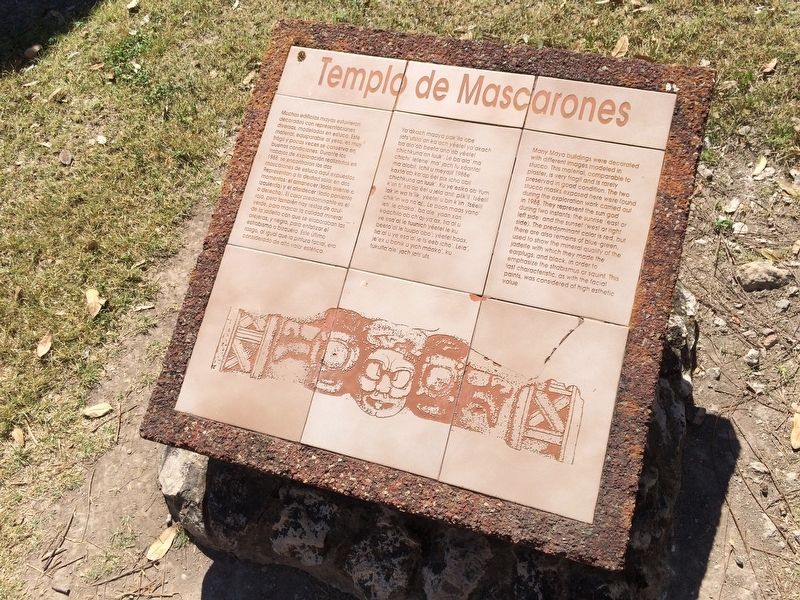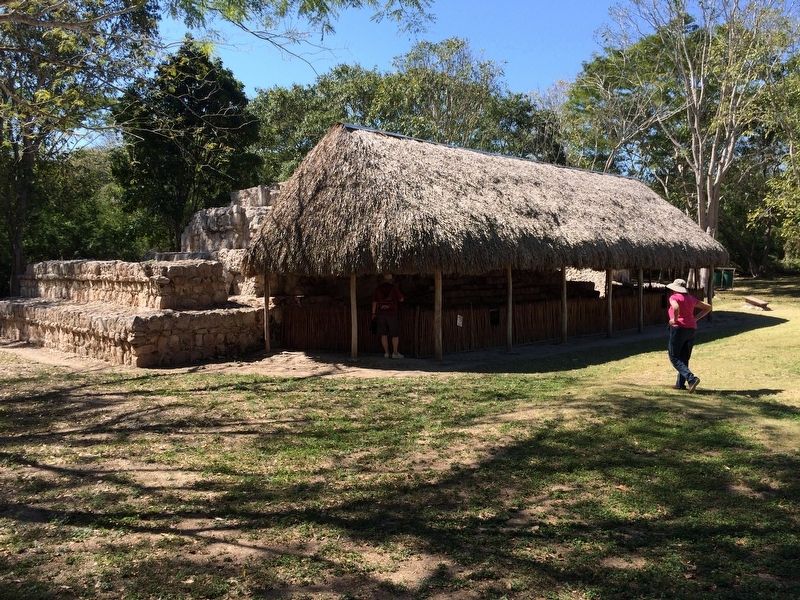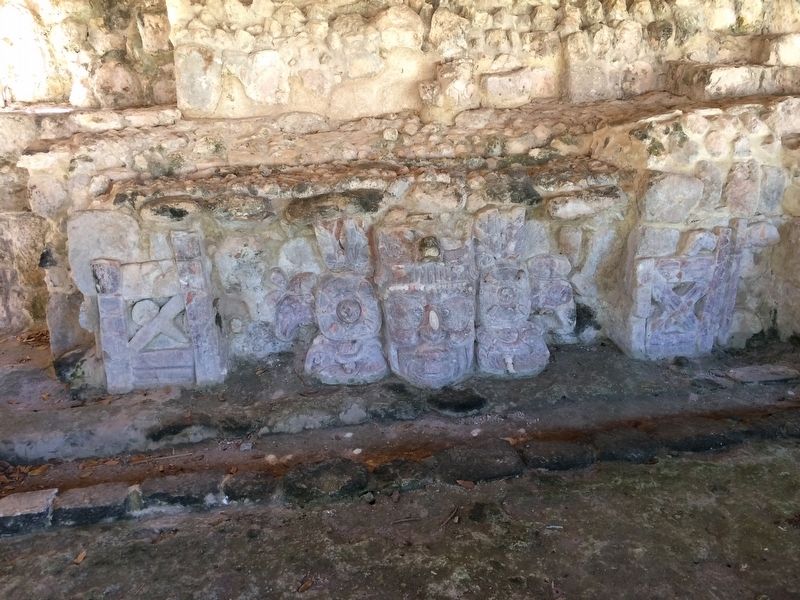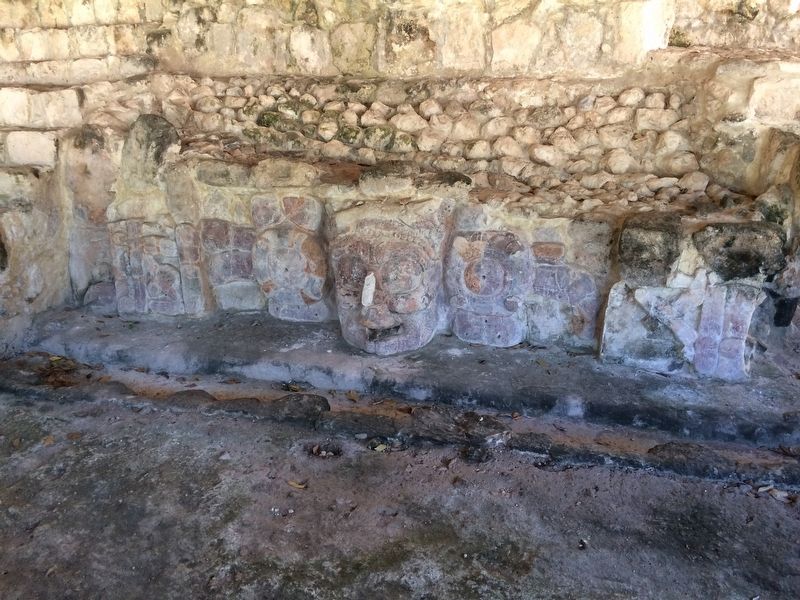Edzná in Campeche, Mexico — The Southeast (Yucatan Peninsula)
The Temple of the Giant Masks
Templo de Mascarones
Muchos edificios mayas estuvieron decorados con representaciones diversas, modeladas en estuco. Este material, equiparable al yeso, es muy frágil y pocas veces se conserva en buenas condiciones. Durante los trabajos de exploración realizados en 1988, se encontraron los dos mascarones de estuco aquí expuestos. Representan a la deidad solar en dos momentos: el amanecer (lado oriente o izquierdo) y el atardecer (lado poniente o derecho). El color predominante es el rojo, pero también hay restos de azul-verde, para marcar la calidad mineral de la jadeíta con que se elaboraron las orejeras; y negro, para enfatizar el estrabismo o bizquera. Este último rasgo, al igual que la pintura facial, era considerado de alto valor estético.
Maya-Yucateco:
Ya’akach maaya pak’ilo’obe’ jats’utsta’an ka’ach y’éetl ya’akach ba’alo’ob beeta’ano’ob yéetel chichkuna’an luuk’. Le ba’alo’ ma’ chichi’ leten’ ma’ jach tu xáantal ma’alobil. Ichil u meyajil 1998e’ kaxta’ab ka’ap’éel pix icho’obil chichkuna’an luuk’. Ku ye’esiko’ob Yum k’iin ti’ ka’ap’éel u jela’anil: píik’il (tséelil lak’in wa ts’íik) yéetel u bin k’iin (tséelil chik’in wa no’oj). Le boon maas yano’ leti’ le chako’, ba’ale’ yaan xan káachilo’ob ch’oj-ya’ax, tia’al u ye’esa’al le tuunich yéetel le ku beeta’al le tuupo’obo’ ; yéetel boox, tia’al u ye’esa’al le ts’eeb icho’. Lela’, je’ex u bonik u yich máako’, ku tukulta’ale’ jach jats’uts.
English:
Many Mayan buildings were decorated with different images modeled in stucco. This material, comparable to plaster, is very fragil and is rarely preserved in good condition. The two stucco masks exposed here were found during the exploration work carried out in 1988. They represent the sun god during two instants: the sunrise (east or left side) and the sunset (west or right side). The predominant color is red, but there are also remains of blue-green, used to show the mineral quality of the jadeite with which they made the earplugs; and black, in order to emphasize the strabismus or squint. This last characteristic, as with the facial paints, was considered of high esthetic value.
Topics. This historical marker is listed in these topic lists: Anthropology & Archaeology • Architecture • Man-Made Features • Native Americans. A significant historical year for this entry is 1988.
Location. 19° 35.754′ N, 90° 13.839′ W. Marker is in Edzná, Campeche. Marker can be reached from Route 188. The marker is to the right when facing the Temple of the Giant Masks at the Edzná Archaeological Site some 50 kilometers southeast of Campeche. Touch for map. Marker is in this post office area: Edzná CAMP 24570, Mexico. Touch for directions.
Other nearby markers. At least 8 other markers are within walking distance of this marker. The Small Acropolis (within shouting distance
of this marker); The Ball Game at Edzná (within shouting distance of this marker); The Building of the Five Floors (about 150 meters away, measured in a direct line); The Great Acropolis (about 180 meters away); Nohochná (about 180 meters away); The Platform of the Knives (about 240 meters away); The Ambassadors' Platform (approx. 0.3 kilometers away); The Maya (approx. half a kilometer away). Touch for a list and map of all markers in Edzná.
Regarding The Temple of the Giant Masks. The English translation given on the marker is not exactly clear about the characteristic of the masks which it translates as "strabismus or squint", which is probably better described as "crossed eyes". This feature was highly valued in ancient Mayan culture.
Credits. This page was last revised on March 20, 2024. It was originally submitted on April 30, 2017, by J. Makali Bruton of Accra, Ghana. This page has been viewed 153 times since then and 8 times this year. Photos: 1, 2, 3, 4. submitted on April 30, 2017, by J. Makali Bruton of Accra, Ghana.



